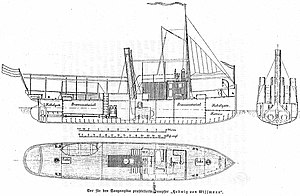Hedwig von Wissmann (steamship)
 Plans of Hedwig von Wissmann
| |
| History | |
|---|---|
| Name | Hedwig von Wissmann |
| Builder | Janssen & Schmilinsky, Hamburg |
| Launched | 1897, 6 November 1900 |
| In service | 20 September 1900 |
| Fate | Sunk, 9 February 1916 |
| General characteristics | |
| Type | Steam ship |
| Displacement | 60 metric tons (59 long tons; 66 short tons) |
| Length | 20 m (66 ft) |
| Beam | 4.26 m (14.0 ft) |
| Height | 2.3 m (7 ft 7 in) |
| Draught | 1.25 m (4 ft 1 in) |
| Propulsion | Steam engine, 85 PS (63 kW) |
| Speed | 9 knots (17 km/h; 10 mph) |
| Capacity | 400 |
| Crew | 14 + 14 |
| Armament |
|
| Notes | 7 killed/20 captured (including 2 wounded) |
The Hedwig von Wissmann was a German steamboat on Lake Tanganyika, which became a feature in the story behind the film The African Queen. She was sister vessel to the larger Hermann von Wissmann on Lake Nyasa, and like that vessel originally used as a gunboat against slavers. Hedwig von Wissmann was the wife of the German explorer and colonial administrator Hermann von Wissmann who had raised funds for both boats.
On 12 August 1914 she was drafted for guard service on Lake Tanganyika. She was sunk by an Anglo-Belgian flotilla of small boats under Geoffrey Spicer-Simson in on 9 February 1916 at 11h50 in the Battle for Lake Tanganyika including HMS Fifi and HMS Mimi.[1]
German casualties were engineer and two African stokers killed in the engine room; a warrant officer and some African crew members killed[2] and a European stoker and an African seaman slightly wounded when two of the ships boats were hit by shells. Twelve Europeans, including the captain Job Odebrecht,[3] and eight Africans were captured by the British.[4]
References[]
- ^ Pan-African chronology III Everett Jenkins - 2001 "On February 9, in the early hours in the morning the German warship the Hedwig von Wissmann was sighted steaming down the ... At 100 tons, the Hedwig von Wissmann was more than twice the size of the now British manned Kingani (HMS Fifi) ..."
- ^ Apparently three African crew killed. See Battle for Lake Tanganyika Footnote # 55.
- ^ He served in World War II as a general in the Luftwaffe
- ^ National Geographic October 1922 .pp.362-363
- Steamships of Germany
- 1897 ships
- World War I auxiliary ships of Germany
- Lake Tanganyika
- Maritime incidents in 1916
- World War I shipwrecks
- Shipwrecks of Africa